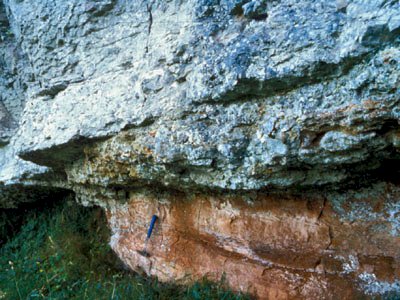Earth Science Conservation Review
| Murlough Bay | Antrim |
| Site Type: | Coastal section |
| Site Status: | ASSI |
| Grid Reference: | D192416 |
| Google maps: | 55.20752,-6.12757 |
| Rocks | |
|---|---|
| Rock Age: | Cretaceous (Coniacian, Santonian, Turonian) |
| Rock Name: | Cretaceous Basal Conglomerate |
| Rock Type: | Conglomerate |
| Interest | |
| Fossil Groups: | Ammonite, Belemnite, Brachiopod, Sponge |
| Other interest: | sea-floor 'high' |
Summary of site:
In Murlough Bay, Co. Antrim, on the rim of the bay to the east of the road, there is a prominent cliff of Cretaceous Ulster White Limestone standing directly on the Triassic Sherwood Sandstone. The time interval separating the Sherwood Sandstone Group and the Ulster White Limestone Formation is almost exactly 150 million years, and it is the evidence found in the basal conglomerate underlying the limestone, giving hints of events in that missing period, that is the main interest of this site.
Breaks in rock sequences are usually due to periods of emergence, when an area was dry land and therefore not available to receive sediment and was more likely to be eroding. There is also the possibility that some rocks were deposited, only to be removed by later erosion, leaving little or no evidence that they ever existed.
In other parts of Northern Ireland, rocks of the early Jurassic period (called the Lower Liassic, or Lias) are found on top of the Sherwood Sandstone. They represent between a quarter and a third of Jurassic time; no later Jurassic rocks are found in Northern Ireland.
At Murlough Bay the junction between the Sherwood Sandstone and the Ulster White Limestone is marked by a conglomerate, between 15 and 45cm thick. It consists of pebbles in a sandy chalk matrix, a rock typical of the shoreline of a vigorously encroaching sea. The pebbles consist of quartz (identical to the quartz pebbles in the Sherwood Sandstone), older Dalradian rocks (also found nearby) and a yellow sandstone.
Fossils of animals living in the sea are also found but, surprisingly, Jurassic fossils also occur. These form pebbles containing recognisable fragments of ammonites large enough to be identified, including species restricted to the top of the Lower Lias, the Middle Lias and much of the Upper Lias - rocks of an age not found in Northern Ireland.
There is still discussion about the age of the Cretaceous conglomerate; the best estimate, based on the fossil evidence, is Coniacian (approximately 85 million years ago, about three quarters of the way through the Cretaceous).
The conglomerate at Murlough Bay gives clear evidence that rocks of Middle and Upper Liassic age were deposited close by, and that during the late Cretaceous marine transgression (about 85 million years ago) they were eroded by the advancing sea and became incorporated as rare pebbles into shoreline shingle. Intriguingly, there is no obvious source area for these Jurassic rocks. The site is unique in Northern Ireland - no other conglomerate at the base of the Cretaceous contains Jurassic fossils and, consequently, it continues to generate interest and has considerable future research potential.
Breaks in rock sequences are usually due to periods of emergence, when an area was dry land and therefore not available to receive sediment and was more likely to be eroding. There is also the possibility that some rocks were deposited, only to be removed by later erosion, leaving little or no evidence that they ever existed.
In other parts of Northern Ireland, rocks of the early Jurassic period (called the Lower Liassic, or Lias) are found on top of the Sherwood Sandstone. They represent between a quarter and a third of Jurassic time; no later Jurassic rocks are found in Northern Ireland.
At Murlough Bay the junction between the Sherwood Sandstone and the Ulster White Limestone is marked by a conglomerate, between 15 and 45cm thick. It consists of pebbles in a sandy chalk matrix, a rock typical of the shoreline of a vigorously encroaching sea. The pebbles consist of quartz (identical to the quartz pebbles in the Sherwood Sandstone), older Dalradian rocks (also found nearby) and a yellow sandstone.
Fossils of animals living in the sea are also found but, surprisingly, Jurassic fossils also occur. These form pebbles containing recognisable fragments of ammonites large enough to be identified, including species restricted to the top of the Lower Lias, the Middle Lias and much of the Upper Lias - rocks of an age not found in Northern Ireland.
There is still discussion about the age of the Cretaceous conglomerate; the best estimate, based on the fossil evidence, is Coniacian (approximately 85 million years ago, about three quarters of the way through the Cretaceous).
The conglomerate at Murlough Bay gives clear evidence that rocks of Middle and Upper Liassic age were deposited close by, and that during the late Cretaceous marine transgression (about 85 million years ago) they were eroded by the advancing sea and became incorporated as rare pebbles into shoreline shingle. Intriguingly, there is no obvious source area for these Jurassic rocks. The site is unique in Northern Ireland - no other conglomerate at the base of the Cretaceous contains Jurassic fossils and, consequently, it continues to generate interest and has considerable future research potential.
| Enlander, I., Dempster, M. & Doughty, P., 2025. Murlough Bay, County Antrim, site summary. [In] Earth Science Conservation Review. https://www.habitas.org.uk/escr/summary.php?item=117. Accessed on 2025-04-03 |
| Previous Site | Next Site |
